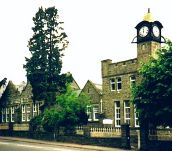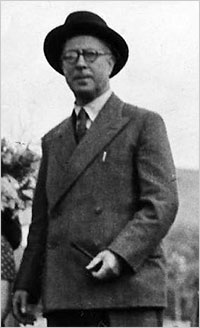
Aberdare Boys’ Grammar School
Athletics

Newspaper Report of 1934 Sports Day
The athletics Sports Day in 1934 was presided over by the headmaster Walter Charlton Cox, with the mining engineer and barrister Glen George presenting the prizes. More information about Mr. George is given at the bottom of this webpage. The text below is a transcript of the report on the Sports Day from The Western Mail. An image of the original article can be seen using the link at the bottom of this page.
ATHLETIC SPORTS
Aberdare County School Winners
Despite the fact that rain marred the annual sports of the Aberdare Boys’ County School, the event attracted a large crowd to the Robertstown field on Thursday.
This year the sports and distribution of certificates were held on the same day, and the certificates, house medals, “caps,” and prizes were distributed to the pupils by Mr. Glen George.
Mr. W. Charlton Cox (headmaster), in his review of the year’s work, stated that of 19 candidates who sat for the higher certificate eight passed and that 63 of the 82 who sat for the school certificate passed.
The W. M. Llewellyn Cup awarded the Victor Ludorum was won by W. F. Barling, the runner-up being G. Jones.
Glyn Jones and A. B. James, who tied for first place in the senior long jump, beat the existing record with a Jump of 18ft. 11½in. Results :—
100 Yards Scratch.—lst, W. F. Barling; 2nd, J. R. Evans.
100 Yards Junior Handicap.—1st, J. M. Roberts; 2nd, D. G. Ellis.
High Jump (Senior).—1st, D. D. Davies (4ft. 10in.); 2nd, F. Barling.
Long Jump (Junior).—1st, D. G. Ellis (l6ft.); 2nd, J. M. Roberts.
100 Yards Handicap—1st, C. Alder; 2nd, E. Davies.
100 Yards (Open).—1st, tie between J. M. Roberts and D. G. Ellis; 2nd, tie between J. R. Evans and G. G. Jones.
High Jump (Junior).—1st, K. Knight (4ft. 1in.); 2nd, J. M. Roberts.
Long Jump (Senior).—Tie between G. Jones and A. B. James (18ft. 11½in.).
220 Yards (Forms 1A and 1B).—1st, H. Butler; 2nd, R. Edwards.
100 Yards Junior Hurdles—lst, W. T. Jenkins; 2nd, R. Eynon.
Sack Race.—1st, A. Morgan; 2nd, E. Davies.
220 Yards (Junior).—lst, D. Ellis; 2nd, R. Price.
Inter-County School Relay Race.—lst, Barry; 2nd, Porth; 3rd, Pontypridd.
Throwing the Cricket Ball.—lst, W. G. Richards; 2nd, R. Reynolds.
220 Yards (Open).—lst, D. E. Davies; 2nd, G. G. Jones.
Consolation Race—lst. R. Harp; 2nd, K. Jones.
440 Yards (Open).—lst, A. L. Lewis; 2nd, C. J. Morgan.
100 Yards Hurdles (Senior).—1st, W. F. Barling; 2nd, G. G. Jones.
Past Students’ Race.—T. Barling.
880 Yards (Open).—lst, J. I. Davies; 2nd, A. Lewis.
The Barling Brothers were the sons of the mining engineer and colliery manager Gilbert Barling. There is a full account of Tom’s career in the Former Pupils section of this website. Tom was the eldest of the three boys. A brother W. F. (Fred) Barling, County School 1929–35, died in 1990. He, like Tom, went to Birmingham University and for forty years taught French, and latterly until his retirement was deputy head of The Haberdashers’ Aske’s Boys School, at both Hampstead and later Elstree. The youngest brother, Mansel, lived in Gloucestershire. He went to UCW Aberystwyth and was subsequently from 1946 a lecturer in agriculture at the Royal Agricultural College, in Cirencester, Gloucestershire. Both brothers had legendary followings at their respective institutions – and both were known as Dai to their academic colleagues.
Document image reproduced with permission of Rhondda Cynon Tâf
Library Service

Maelgwyn Glendower George,
M.B.E., B.Sc., B.A.L., M.I.C.E., M.E., F.G.S.
‘Glen’ George, (1880–1958), was at one
time a very well known figure in Aberdare. However, he is not as familiar in the town
as some others of his era due to his long periods of working abroad and in other areas
of the south Wales coalfield.
His father was Griffith George, J.P., a draper who ran The Bee Hive in Victoria Square. Glen George was brought up in the family home, The Laurels, Meirion Street, Trecynon. He attended Park School before transferring to Bishop Gore School, Swansea for his secondary education.
He studied mining at U.C. Cardiff, and for some years afterwards was a surveyor at the Cambrian Collieries at Clydach Vale. He was then, at the age of just 24, appointed lecturer at the Royal College of Mines, Kensington, London. Then followed a long spell in the mining industry in India.
He holds a rather unique achievement of marrying in a Baptist Chapel, but exceptionally in Calcutta. His bride was Marie Elizabeth John of Glynneath.
He was awarded an MBE in June 1941 with the citation Chief Air Raid Warden, Aberdare Area. Whilst in Aberdare the couple lived at Ty Draw.
His obituary published in The Aberdare Leader is reproduced
below:
An outstanding
Aberdare townsman
MR. GLEN GEORGE
I T was with deepest regret that townspeople heard of the death at Swansea of Mr Glen George, for many years a member of the District Council and prominent townsman at Aberdare — for no-one had ever held the interests of the town and community closer to heart or rendered public service so ably and willingly.
He and Mrs George, to whom the most sincere sympathy is now expressed, had made their beautiful home at Ty Draw one of the centres of community service at Aberdare, and at the same time they had taken a special interest in the people of the little community of Ty Draw, clustered just below their own residence. Their many deeds of benevolence and unobtrusive kindnesses are still remembered.
In the wider spheres of professional and social life, Mr George had been very active. He was a Member of the Institution of Civil Engineers, a Bachelor of Science, and a Barrister-at-Law, and had a notable career as a civil and mining engineer.
First engineering graduate of the University of Wales, he spent 15 years in India, becoming general manager of the largest group of collieries in the East, the Bengal Coal Company, and he was consultant to the Government of India Salt Mines. He retired in 1922 and returned to Aberdare.
He was not the man to be inactive. His broad liberal ideas, outstanding grasp of administration, and progressive outlook, found expression on the District Council, of which he was a member for 12 years, reaching the chair.
He was a leading member and chairman of the Hospital Management Board and chairman of the Appeals Tribunal of the National Assistance Board.
He took great interest in his old University College (Cardiff), and was a member of its executive committee and finance committee.
He was at the Bishop Gore School, Swansea, when Dr. Turpin was headmaster, and was head boy and founder of the school magazine.
Although he had lived in India so long and in recent years had spent much time away from Aberdare, partly in London, his heart was always with his home town, and his desire to maintain the strongest possible associations with it was shown by the gift he made of an avenue of beautiful rose trees to be planted in Aberdare Park, which will perpetuate his name.
Remembrance of him will live for another reason in the hearts of many old friends in Aberdare — for the way he gave of his great ability to further the interests and welfare of the town in every way he could.